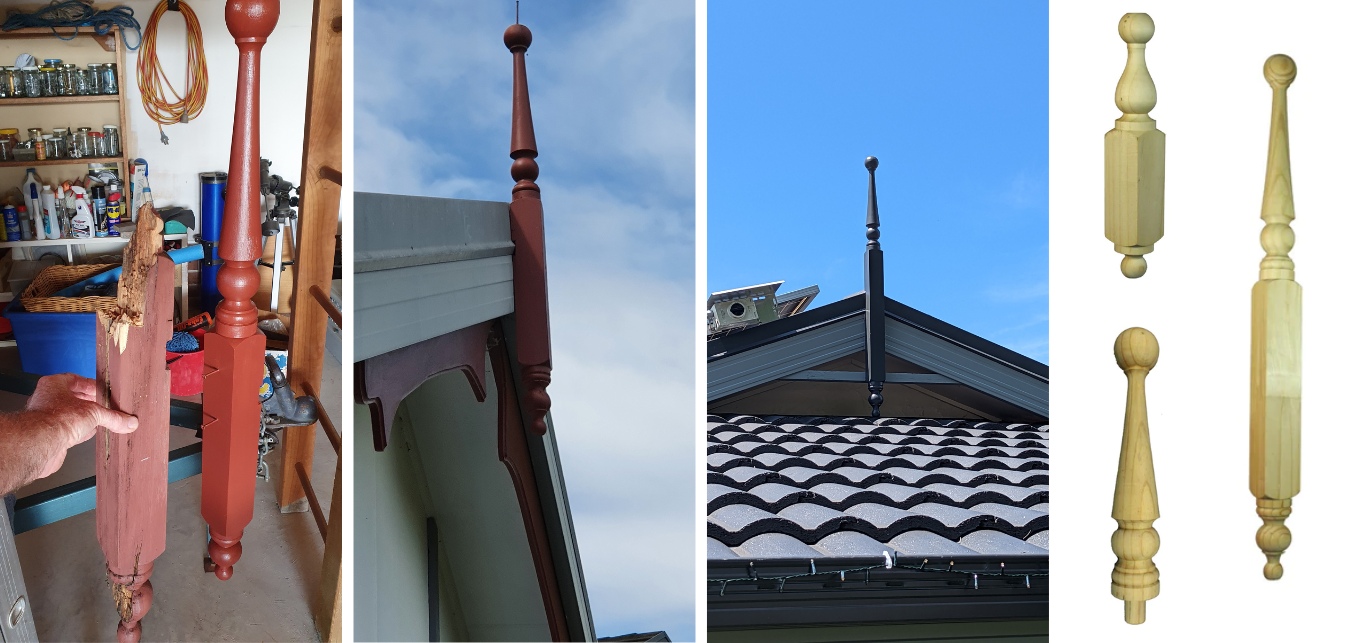How To Install or Replace Roof Finials and Gable Spires
How To Install or Replace Roof Finials and Gable Spires
You might be surprised to learn that there are no hard and fast rules when it comes to installing roof finials and gable spires. Almost every installation will vary slightly from each other depending on the style and age of the house it is being installed on. With that being said, installing roof finials does not generally require any specialty tools or equipment, just standard timber screws or nails.
Learn How to Install Roof Finials

How to install roof finials
Installing a new roof finial / gable spire
If you are installing a roof finial on a home or building that has not previously had a gable spire or finial installed, you must first determine whether the structure is properly suited for one.
Generally speaking, roof finials are installed on australian bungalow or federation style homes which include a timber facia. These facias make perfect mounting structures for roof finials. Sometimes, additional timber structure will be installed along the bottom of the finial for additional support. See the below image for an example of this.

The bottom turned section of the roof finial should always be installed just below the bottommost fixing, whether that be the additional timber support, or the facia itself. Some more examples of how these finials are generally fit can be seen below.
 |
 |
How to replace existing roof finials and gable spires
As mentioned earlier in this article, there is unfortunately no standardised method for affixing roof finials or gable spires to your home. Each installation will vary slightly from one another.
With that being said, most roof finials will be attached directly to the timber facia using timber screws or nails. We recommend inspecting the current/damaged roof finial for fixing points to determine exactly where these might be on your own roof. If the screws/fixings are not immediately visible, it is likely that the finial has been fixed through the front face, and covered with timber putty- as this is the most common fixing method. See below for more information on how to remove this putty.
Some roof finials may require additional support at the base. This wooden support is not a specialty item, but often just a standard length of timber.
The finials themselves can be purchased through our website via the link below.

How to remove damaged roof finials / how are roof finials attached?
Almost all roof finials will be attached to your roof using timber screws or nails, only in extreme circumstances will it have been attached using wood glue. This is due to the fact that roof finials are already susceptible to being damaged or becoming dislodged in high winds - so proper fixings are needed to keep it in place.
This means that removing your roof finial should be as easy as locating these timber screws/nails and removing them. There should be at least two fixing points on most finials.
If the screws are not immediately visible, and the finial is instead recessed between two facias, there are likely hidden fixings through the front face of the finial which will have been filled/covered with putty or filler. You can usually spot these areas by inspecting the paintwork and looking for small discrepancies.
Once the filler has been located, it can be removed using a sharp tool such as a screwdriver (or other metal instrument). It is extremely important to take care when handling tools like these, especially at height.
Related reading: What Is H3 Treatment & How To Care For H3 Treated Products
What size roof finial or gable spire do i need?
The most popular/common roof finials on the market measure between 1m and 1.2m in length, and tend to be approximately 65mm-90mm wide, depending on your preference.
When installing a new roof finial, sizing ultimately comes down to personal preference, however when replacing an existing roof finial it is important to match the dimensions of the existing finial, as parts of the facias may have been removed to allow space for the finial. Therefore, width is particularly important to match.
If the bottom of an existing finial has been dislodged or destroyed, you can estimate the length of the finial by measuring to the bottommost fixing point, and then adding 100-150mm.
There is no way to estimate the size of a finial from the ground, you will need to remove the existing finial to take these measurements, as there is no standardised sizing when it comes to gable spires.
Do i need to create a recess in my facia?
Not all roof finial installations are the same. The short answer to this question is no, you do not, however this ultimately depends on what style/look you are trying to achieve, and whether there is any overlapping of the facia/shingles/bargeboards.

